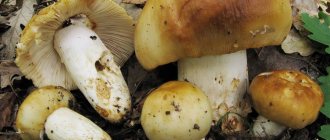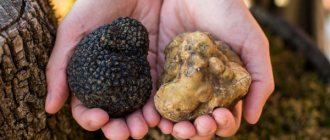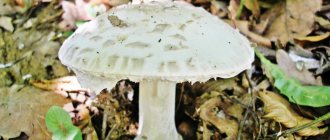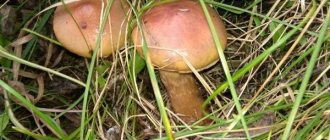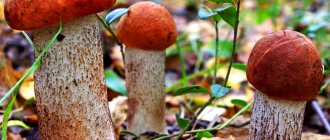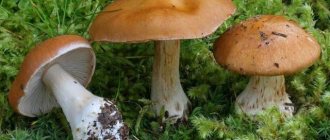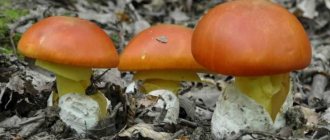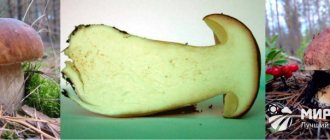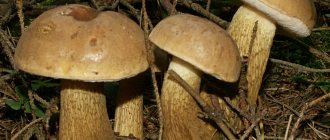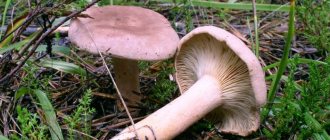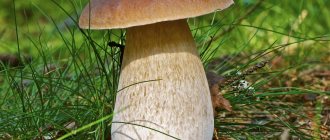Milk mushrooms have been valued since ancient times for their taste. But few fans of “silent hunting” know that the “king of mushrooms” has many conditionally edible doubles, which, after appropriate processing, are in no way inferior in taste and benefits to the body. One of these representatives of the mushroom world is the felt or violin milk mushroom, which received its name for the unusual creaking that occurs when the caps come into contact with each other.
Characteristics and description of a conditionally edible mushroom
Felt milk mushroom (Latin name Lactarius vellereus) is a conditionally edible mushroom, which is assigned the IV category of edibility. Belongs to the class Agaricomycetes from the genus Mlechnik, family Russula. Popularly it has many other names:
- violin;
- squeaky;
- aspen creaking;
- violinist;
- breadcrumbs;
- spurge;
- milk scraper;
- milkweed milkweed.
All names come from the unusual properties of the mushroom:
- when it comes into contact with foreign objects, it makes a squeaking sound;
- When the pulp is cut, an acrid, milky juice is released.
The fruit body has a peculiar mushroom taste and smell. You can recognize a squeak by the following features:
The hat has a dense, fleshy structure, a little dry, with a felt surface that makes creaking sounds when it comes into contact with any objects. The diameter of the cap varies from 6 to 25 cm.
It changes its shape as the mushroom matures, from flat or slightly convex with drooping edges to funnel-shaped with cracked edges.
With age, its color also changes: the young fruiting body has a milky cap, while the old one has a more saturated tone with an ocher tint and yellow spots.
Hymenophore, the lower part of the fruiting body of the mushroom, on the surface of which there is a thin spore-bearing layer (hymenium). The squeaky bird has a plate-like appearance. Equipped with rare plates 4-7 mm wide, greenish or cream-colored, slightly hanging on the stalk, which acquire a yellowish tint when ripe. The spore material is white in color with round spores covered with small spines.
The flesh when cut is greenish-yellow, bitter in taste, hard, brittle, and crumbles easily when pressed. It produces a milky sap that turns yellow when exposed to air and turns reddish-brown when dried.
The leg is straight, solid, with a felt surface, slightly tapering in the area of the cap, bright white. It reaches a maximum length of 6 cm, and its thickness does not exceed 3.5 cm. It has a dense consistency.
Video
A little history
The genus Lactarius was first discovered by the Dutch botanist-mycologist Christian Heinrich Persen in 1797, consisting of six species. He published this information in his book Observationes Mycologicae.
What is the difference between a milk mushroom and a creak
It is quite easy to distinguish a milk mushroom from a violin if you know what exactly to look for.
What does a white breast look like?
White milk mushroom (Lactárius résimus), also called the real one, belongs to the genus Mlechniki and the family Russula. It grows to large sizes, with a diameter of 8 to 20 cm. The cap is white, white-cream; with age, uneven dark yellowish-ocher spots appear. The surface is fleecy, and in wet weather it is distinctly slimy. The cap of young specimens is spread out, with a small depression in the center, the edges are wrapped in a neat pubescent roll. Mature mushrooms are funnel-shaped with a distinct depression at the junction with the stem, the upper part of which is smoothly curved downwards. The mushroom has a characteristic fruity aroma; when cut or broken, a bitter white juice is released, which quickly darkens to yellow or brown.
Important! Experienced mushroom pickers do not recommend collecting fruiting bodies with spotted caps, as they are overgrown.
Thin, smooth plates of the hymenophore; they can be distinguished with the naked eye
What does the loader look like?
White russula (Russula delica), also called russula sweet, belongs to the Russula family, genus Russula. The fruit body has a dry, hairless cap. It grows to gigantic sizes, from 15 to 30 cm in diameter. The color is cream, white-gray with rusty spots. The shape can be spread out with the edges rolled up and a depression in the center, or funnel-shaped. Old specimens darken and can be distinguished by their rich brown tint. A large amount of earth and forest litter accumulates on the cap. The plates are thin, narrow, cream-colored, with a characteristic sea tint if the cap is tilted towards the light. The leg is strong, light, dense, with uneven brown spots. The pulp is juicy, richly aromatic. You can use the loading for food only after preliminary boiling. Unlike the white milk mushroom, the violin and milk mushroom have dense legs, without voids. Only the oldest mushrooms may have voids in their stems.
Two white loads on a moss meadow
What does a squeak look like?
The violin (Lactárius velléreus), otherwise called felt milk mushroom, squeaky milk mushroom, dry milk mushroom or milk scraper, belongs to the genus Mlechnikov and the family Russula. In young specimens, the caps are convex-rounded, with folded edges, then straighten out and become prostrate. Overgrown ones are funnel-shaped, with uneven, sinuous, smooth edges. The diameter can reach from 9 to 27 cm. The surface is smooth, dry, and forest debris rarely sticks to it. Snow-silver color, covered with sparse thin scales. The pulp is very dense, grayish, brittle, with a mushroom aroma and a pungent aftertaste. The milky juice is very pungent and light in color. The plates are sparse, grayish or creamy-yellowish, uneven. The leg is short and thick.
Attention! Squeaky fish are rarely attacked by insect larvae due to their unique taste.
Skripun is distinguished by non-furred, rolled edges and darker, sparse plates
They grow in large groups - both in a tight carpet and in separate fruiting bodies over an area of several square meters. They prefer deciduous forests, mainly birch and aspen forests. They appear a month earlier than the creaks and leave in September. They bear fruit until frost in October-November. Unlike the bitter-pepper squeak, raw white milk mushroom has a sweetish, pleasant taste.
Time and place of fruiting
Violin grows almost everywhere. Young and old fruiting bodies fused into a single group can be found both in Western Europe and the Far East.
The violin mushroom prefers to grow in deciduous, coniferous or mixed forests if the following conditions are met:
- there are many birch and aspen trees, around which the mushroom likes to settle;
- the soil is covered with a layer of moss and old rotted leaves;
- lots of sunshine.
Reference! The fruiting season lasts from mid-summer to late autumn. Mushroom pickers value most the fruiting bodies collected in August; they are considered more juicy and tasty.
Toadstool
Description
Some of the most poisonous mushrooms look quite harmless, showing off to others a white, graceful fruiting body and a thin skirt around a long stem.
The cap is round, sometimes covered with small scales. The leg is thin, the connection to it in young grebes is covered with a film. Sometimes intricate patterns appear on the surface, having a pale greenish tint.
How is it different from milk mushrooms?
Most of all, the toadstool resembles a wild champignon, but sometimes it is mistaken for a milk mushroom.
The main difference is considered to be a kind of volumetric ring at the base of the leg, similar to a cup. Edible mushrooms do not have such an addition.
Another sign is the shape and pale (almost green) color of the cap, a light fruiting body, as well as the habit of growing alone or in a very dense group, literally crushing its neighbors.
Growing at home and in the country
Felt mushrooms can be collected not only in forests, but also grown at home. This process is not particularly complicated; you just need to purchase ready-made mycelium.
When growing, you must follow the following algorithm:
- Mix the mycelium with forest soil and sawdust from deciduous wood.
- In places where many squeaky beetles grow, collect moss and rotted leaves.
- Sow mycelium. Sowing can be done from late spring to early autumn.
- Make a nutrient solution of yeast and sugar for feeding.
If you couldn’t get ready-made mycelium, you can try another method:
- Break overripe mushrooms into small pieces.
- Mix them with peat and sawdust.
- Water with nutrient solution.
- Cover with a lid with small holes.
- Leave for three days indoors at a temperature of about +23 degrees Celsius.
- Prepare the soil by treating it before planting with a lime solution prepared at the rate of 50 g of the substance per 10 liters of water.
- Make holes closer to the deciduous tree.
- Place the prepared substrate in the hole, filling it halfway.
- Lay the mycelium in the next layer and cover it with soil and lime on top.
- Cover with moss and rotten leaves.
Reference! Felt milk mushrooms can be grown both in the basement and in the barn. To do this, just make several holes in plastic bags and place the mycelium in them. In this case, the harvest can be harvested for five years in a row.
Shelf life of blanks
Squeaky milk mushrooms salt extremely quickly, so they can be consumed within a week. The shelf life directly depends on the method of preparing the creaks. If greens were used, then it is better to use such preparation within six months.
In other cases, the shelf life of such canning is ten months - with the correct preparation technology. If the jars have not been sterilized, they may explode or develop mold.
False doubles
The violin definitely does not have any absolutely inedible or poisonous counterparts. But it has similarities with other representatives of the mushroom world, for example, with real, dry and pepper milk mushrooms. You can clearly see the difference between them in the photo; they differ in taste and some external characteristics:
| Violin | Real breast milk (white) | Loader white | Pepper milk mushroom | |
| hat | With a felt surface, it makes a squeaking sound when in contact with foreign bodies | Densely pubescent with fringed edges | With light felt covering | Has a smooth surface |
| milky juice | Bitter with a burning taste, light in color; when exposed to air, it acquires a slight yellowish tint, and when it dries it becomes red-brown. | White in color, bitter in taste, when cut it acquires a gray-yellow tint. | Doesn't have | Light in color, with a peppery taste; when the cap is broken, it changes color to olive green |
| Leg | Solid with a dense structure | In adult mushrooms it is hollow | In adult fruiting bodies, it acquires a brownish tint and becomes hollow. | Solid |
| Records | Rare, thick | Infrequent, wide | Frequent, thin | Frequent, narrow |
Reference! Both the white milk mushroom and the creaking milk mushroom secrete milky juice at the cut of the cap. But in real milk mushrooms, when exposed to air, it acquires a gray-yellow color, while in felt milk mushrooms, the shade of the juice practically does not change.
You can also confuse the squeaky one with the white one - the white wave. However, both mushrooms have signs by which they can be easily distinguished:
- the white milk mushroom has a rich white color, while the felt milk mushroom has a milky tint, which becomes darker with age;
- the white wave is smaller in size than the creaking one; the diameter of its cap can reach a maximum of 6 cm; the cap also differs in shape, since it has edges curved inward.
Violin
Skripitsa is a conditionally edible mushroom, that is, one that requires specific processing to become edible. It belongs to the genus of laticifers, and the mushroom received its characteristic name due to the fact that when you touch the cap, it makes a creaking sound. Popularly, this mushroom is also called spurge, and in most civilized countries it is considered inedible, which, in general, is correct. This type of mushroom is quite common in Russia; it is white in color with a large cap, which sometimes grows up to 25 centimeters in diameter. The cap is quite massive, a hole is formed in the center, and the cap is reddish in color. The leg is low and quite thick: usually 5 cm in height and the same in diameter.
The violin very rarely attracts the attention of insects or worms, just like an ordinary milk mushroom, so some mushroom pickers still collect it for further use. It reproduces by spores, which are located in the plates at the bottom of the cap.
The fact that violin is classified as a conditionally edible mushroom has come to us since the times of the USSR, where this mushroom was included in GOST as edible after pickling. However, most foreign mushroom pickers, as well as scientists, classify it as an exclusively inedible mushroom, and, in general, they do the right thing. Unlike milk mushrooms, violin does not have a pleasant taste; even after prolonged salting and boiling, it remains extremely mediocre in taste and very few people like it. Salting is necessary in order to get rid of violin juice, which can be considered conditionally poisonous; it has a very bitter and unpleasant taste.
The main purpose of salting is to get rid of this juice, replacing it with salt.
Evaluation of taste qualities, medicinal properties, benefits and possible harm
The taste of fresh violin is quite pungent, with a significant aftertaste of bitterness, which does not disappear even after heat treatment. It contains trace elements that irritate the gastrointestinal tract and cause a gag reflex, so this mushroom should not be consumed raw.
But after proper processing, the fruiting body gets rid of harmful substances and is able to supply the body with amino acids, fiber, vitamins and minerals.
One serving contains the daily dose of iron, sodium, phosphorus and potassium. And the low calorie content (22 kcal per 100 g) makes this mushroom suitable for dietary nutrition.
Frequent consumption of felt milk mushrooms contributes to:
- normalization of cholesterol and blood sugar levels;
- maintaining good health;
- general strengthening of the immune system;
- restoration of energy balance;
- protection against viral and bacterial diseases.
Due to its rich chemical composition, violin is widely used in folk medicine. In China, it is used to treat pain in the joints, tendons of the limbs and pelvic bones.
But there are a number of contraindications:
- gastrointestinal diseases;
- liver and kidney diseases;
- gout;
- allergic reactions;
- pregnancy and lactation period.
Important! This mushroom is not recommended for consumption by children under 12 years of age due to the severity of digestion and high salt content.
Further storage
For long-term storage, the workpiece must be placed in a cool place - a refrigerator or cellar. A room whose temperature is less than 15 degrees is best.
The most optimal temperature for storing salted forest products is up to 5 degrees. In winter, preserves are often stored on the balcony, if the temperature permits.
Cooking recipes
Skripitsa is classified as a conditionally edible mushroom, which is assigned the fourth category of edibility. When properly processed, it is safe for the body, therefore it is successfully used in cooking. Skripun can be prepared for future use, pickled, and salted.
Primary processing and soaking
Before proceeding directly to the cooking process, it is necessary to carry out primary processing of the fruiting bodies to remove the milky juice from them.
Algorithm of actions:
- Sort through the mushrooms.
- Remove stuck leaves, moss and dirt particles.
- Rinse thoroughly with running water.
Then you can move on to the soaking process, which will help get rid of the bitter taste, toxins and harmful elements. Soaking should be done using two methods:
- Immersion in cold water. It is necessary to place the mushrooms in a salted liquid, in which they should remain for 5-7 days, and periodically change it to fresh liquid.
- Pouring boiling water. This method is considered faster; after only 3 days, the mushrooms are ready for further processing. In this case, the water will have to be changed quite often - up to 5 times a day.
Is it possible to fry and cook fiddle mushroom?
The violin is suitable for eating only in salted form. When boiling or frying, the bitterness in the fruit body remains, and when eating violin prepared in this way, there is a risk of adverse consequences.
Reference! Felt breast milk cannot be considered dangerous, because its composition does not contain any toxic substances that affect internal organs. But an attack of vomiting is possible if it is consumed fresh, boiled or fried.
Pickling
Salted violin is much inferior in taste to white milk mushrooms. But if you find the right recipe, you can get an excellent snack with a pleasant aroma.
For preparations for the winter, fruits with a large and fleshy cap are suitable. It is recommended to select whole and fresh fruit bodies without signs of worms.
Hot
Ingredients:
- pre-soaked violin – 1 kg;
- table salt – 30 g;
- filtered water;
- cloves – 2-3 pcs.;
- fresh currant leaves - several pieces;
- allspice - a few peas;
- bay leaf – 1 pc.
Recipe:
- Pour water into an enamel pan, add salt.
- Place mushrooms in it, blanch them for 20-30 minutes, constantly skimming off the foam.
- Drain in a colander.
- Wait until it cools down.
- Place currant leaves on the bottom of the jar, add spices, add bay leaf.
- Place the creaks on top, caps down, while sprinkling each layer with table salt.
- Cover with currant leaves on top, close with a lid and put in the refrigerator for 1.5 months.
Reference! Currant leaves prevent the formation of mold. They can be replaced with cherry ones.
Cold
Salting for the winter can be cold.
The following ingredients will be required:
- felt milk mushroom – 1 kg;
- bay leaf, cloves, peppercorns, garlic cloves - to taste;
- table salt – 50 g;
- currant or cherry leaves - several pieces.
How to pickle a violin:
- Place the mushrooms in a wooden container in dense layers, caps down, sprinkling each with salt and spices.
- Cover with a ceramic plate on top and place a weight.
- Wait until the liquid is released. It should cover the mushrooms completely, and if this does not happen, then you should add a salt solution on top, prepared at the rate of 20 g of salt per 1 liter of water.
- Place the prepared creak into sterilized jars, caps down.
- Cover the top of the pickle with currant leaves.
- Close with lids.
- Place in the refrigerator for 1.5 months.
Crispy marinated squeaks using the hot method
Felted milk mushrooms can also be pickled and rolled into jars. This process is more labor-intensive because the mushrooms need careful preparation.
But, according to reviews, the pickled squeaky cheese turns out crispy and aromatic.
Ingredients:
- violin – 1 kg;
- water – 1 tbsp.;
- table salt – 40 g;
- onion – 1 pc.;
- cherry leaves - several pieces;
- horseradish leaf – 1 pc.;
- dill umbrella – 1 pc.;
- black peppercorns - to taste.
Step-by-step marinating recipe:
- Peel and rinse the mushrooms in cold water at least three times.
- Fill with water overnight.
- In the morning, drain the water and rinse each mushroom again under running water.
- Place in an enamel container, add water and bring to a boil, periodically skimming off any foam that appears.
- Drain in a colander or sieve.
- Rinse again and soak in cold water for half an hour.
- Drain the liquid and rinse the mushrooms several times.
- Prepare sterilized jars.
- Place spices on the bottom, a layer of mushrooms on top, chopped onion rings and a horseradish leaf on top.
- Boil water for the marinade with salt and pepper.
- Pour brine over the mushrooms, sterilize the jars for 30 minutes, and roll up.
Proper processing
As soon as the mushrooms have been brought home from the forest, the first thing they should do is sort them out and free them from adhering leaves and other dirt. Next, the mushrooms are washed and soaked in salt water. After this, the creaks can be boiled, fried, stewed, made various sauces, dried or pickled, but all this after preliminary boiling.
Soaking lasts 5 days in cold, clean water. This must be done if you decide to pickle mushrooms or cook them in any other way. During this time, the water should be changed several times to clean water.
In addition to the fact that the mushroom contains many useful substances, it also contains harmful components that make the fresh mushroom bitter.
It’s not even a matter of taste; if this mushroom is simply boiled or fried, then attacks of nausea and vomiting and gastrointestinal poisoning may occur, which is why it is so important to pre-soak and dry or pickle them
Video gallery
Video reviews
A selection of videos with descriptions and recipes for preparing mushrooms
Hippolytus Visible, All about everything! Love, Happiness in life!, Marcel homemade
Interesting Facts
The following information is also known about the violin:
- it rarely attracts the attention of insects or worms;
- in the USSR, this mushroom was included in GOST as “edible after pickling”;
- felt milk mushroom is still practically unknown in Europe and is listed as an inedible mushroom.
The felt milk mushroom is one of the most unusual representatives of the mushroom world, which experienced lovers of quiet hunting often avoid due to its peculiar taste and low nutritional value. But if prepared correctly, it can be an excellent alternative to real salted milk mushrooms. Its composition, rich in vitamins and microelements, will complement your diet during the winter.
